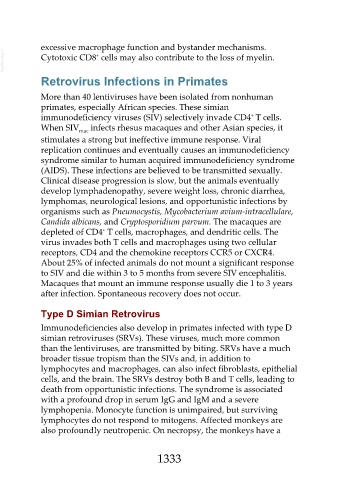Page 1333 - Veterinary Immunology, 10th Edition
P. 1333
excessive macrophage function and bystander mechanisms.
VetBooks.ir Cytotoxic CD8 cells may also contribute to the loss of myelin.
+
Retrovirus Infections in Primates
More than 40 lentiviruses have been isolated from nonhuman
primates, especially African species. These simian
+
immunodeficiency viruses (SIV) selectively invade CD4 T cells.
When SIV mac infects rhesus macaques and other Asian species, it
stimulates a strong but ineffective immune response. Viral
replication continues and eventually causes an immunodeficiency
syndrome similar to human acquired immunodeficiency syndrome
(AIDS). These infections are believed to be transmitted sexually.
Clinical disease progression is slow, but the animals eventually
develop lymphadenopathy, severe weight loss, chronic diarrhea,
lymphomas, neurological lesions, and opportunistic infections by
organisms such as Pneumocystis, Mycobacterium avium-intracellulare,
Candida albicans, and Cryptosporidium parvum. The macaques are
+
depleted of CD4 T cells, macrophages, and dendritic cells. The
virus invades both T cells and macrophages using two cellular
receptors, CD4 and the chemokine receptors CCR5 or CXCR4.
About 25% of infected animals do not mount a significant response
to SIV and die within 3 to 5 months from severe SIV encephalitis.
Macaques that mount an immune response usually die 1 to 3 years
after infection. Spontaneous recovery does not occur.
Type D Simian Retrovirus
Immunodeficiencies also develop in primates infected with type D
simian retroviruses (SRVs). These viruses, much more common
than the lentiviruses, are transmitted by biting. SRVs have a much
broader tissue tropism than the SIVs and, in addition to
lymphocytes and macrophages, can also infect fibroblasts, epithelial
cells, and the brain. The SRVs destroy both B and T cells, leading to
death from opportunistic infections. The syndrome is associated
with a profound drop in serum IgG and IgM and a severe
lymphopenia. Monocyte function is unimpaired, but surviving
lymphocytes do not respond to mitogens. Affected monkeys are
also profoundly neutropenic. On necropsy, the monkeys have a
1333

